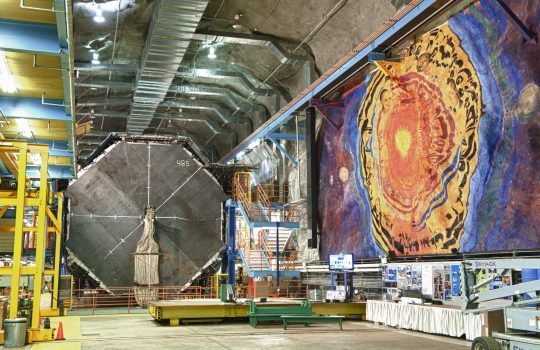Soudan, Minn.-Minnesota Congressman James Oberstar today (July 2) joined scientists and other officials in an underground ceremony dedicating the particle detector for the Main Injector Neutrino Oscillation Search. When the MINOS detector begins operating in early 2005, scientists expect that it will shed new light on the fast-changing field of the physics of neutrinos, subatomic particles with no charge and-or so scientists believed until recently-no mass.
“The MINOS detector dedication represents a milestone in the field of neutrino physics,” said Raymond Orbach, director of the Department of Energy’s Office of Science, from his Washington office. The Department, together with the National Science Foundation, funds the project. “Together with the results from other neutrino experiments around the world, MINOS will help unlock the secrets of these mysterious and ghostly particles, which play such a fundamental role in physics and the universe.”
The MINOS experiment will explore the newly revealed phenomenon of neutrino mass. In contrast to the long-held picture of neutrinos as massless particles, recent results from experiments in Japan and Canada have provided convincing evidence for the existence of “massive” neutrinos. The MINOS experiment will take the next steps in characterizing this newly observed phenomenon.
To carry out the MINOS experiment, scientists will use the Main Injector accelerator at the Department of Energy’s Fermi National Accelerator Laboratory in Batavia, Illinois, to send a beam of muon neutrinos 450 miles, or 735 kilometers, through the earth to a cavern half a mile underground in a former iron mine in northeastern Minnesota. There, the MINOS detector, a 5,500-ton “sandwich” of 456 alternating layers of 8-meter steel plates and plastic scintillator, will look for oscillations, or changes, of muon neutrinos to other neutrino flavors. The observation of such oscillations provides a means of studying neutrino mass.
Dr. Michael Witherell, Fermilab director, welcomed guests to the detector’s dedication Tuesday. Representative Oberstar, of Minnesota’s 8th district where the MINOS detector is located, joined MINOS scientists and officials from the University of Minnesota, the National Science Foundation and the Minnesota Department of National Resources in cutting a ribbon to dedicate the detector.
To date, some 250 of the total number of planes, constituting the detectors first “supermodule,” have been installed. Already, with only roughly half of the detector in place, scientists can detect the interactions of naturally occurring neutrinos coming to earth from space.
“We know our detector works,” said MINOS spokesman Stanley Wojcicki, a Stanford University physicist. “This is a moment that our MINOS collaboration has been working toward for many years.”
The MINOS collaboration includes some 200 scientists from 32 universities and laboratories in France, Russia, the United Kingdom, Greece and the United States.
Fermilab is a Department of Energy National Laboratory operated by Universities Research Association, Inc.



